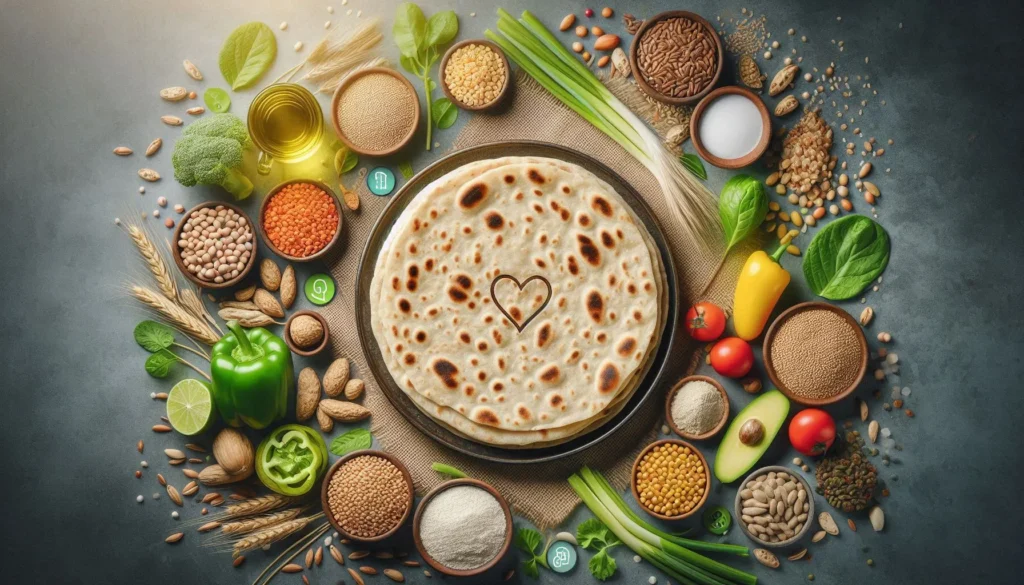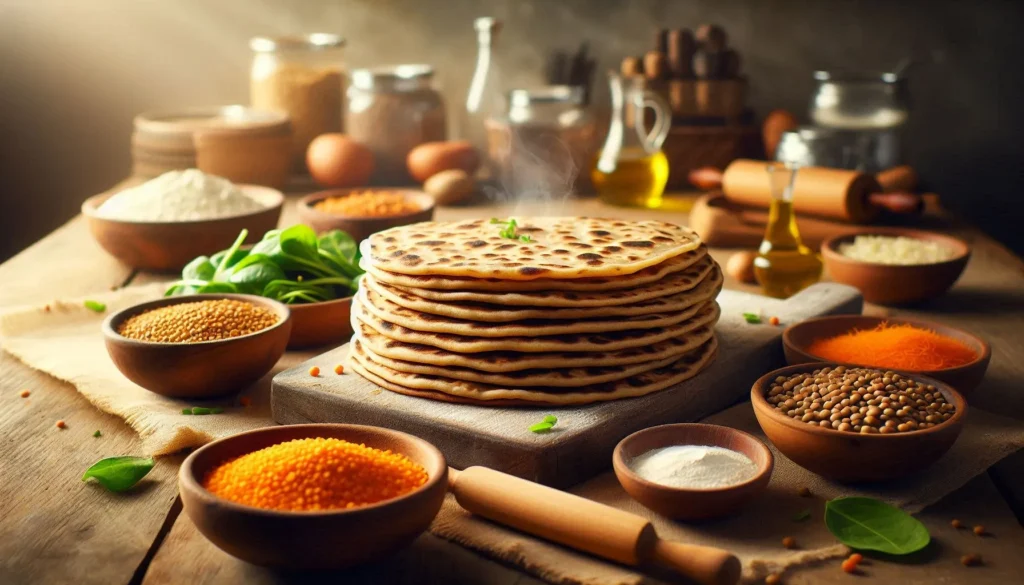Table of Contents
Chapati is not only calorie-rich food; it provides a good amount of necessary nutrients. Full of carbohydrates, chapatis provide stable energy all day long. Moreover, chapatis contain little protein, and if they are made from whole wheat flour, then they provide diet fiber, which is good for digestion. Also, chapati is rich in vital minerals like iron and magnesium, along with B vitamins.
Adding chapati to your diet will help you with both losing and gaining weight, as well as increasing energy levels and digestive health. It is much lower in calories than many types of bread, so it is quite healthy. Knowing the nutritional value of chapati will allow you to make dietary choices that are informed about the delicious flatbread you’re eating without guilt.
What is Chapati?
Chapati is an ancient form of unleavened flat bread widely consumed in South Asia, including countries like India, Pakistan, and Nepal. It is usually prepared from ground whole wheat flour and water and, sometimes, a small amount of oil or ghee for extra flavor and texture. Unlike some other types of bread, chapati does not use yeast or any other agent to make it rise, which gives the product a characteristic texture and flavor.
Cultural Preparation and Variations
Chapati dough is kneaded and then rolled into thin discs. The thin discs of dough are either cooked on a hot griddle or tawa. Traditionally, the dough is rolled so thin that it is soft and evenly cooked. Though overall, chapati takes its basic forms, variations according to regional taste differences exist. Other variations include thicker chapatis with added richness through applying oil or ghee on the dough or as a finish while it is cooking. Multigrain or fortified chapatis are also popular due to healthier alternatives.
Chapati is another such flatbread, compared to naan or paratha; however, it is typically lighter in taste and less fatty. Naan is a preparation that contains yeast and so is normally baked in the tandoor oven, and chapati is uncomplicated and generally stovetop-cooked. Parathas, primarily layered and fried, are normally heavier and considerably more calorie-dense compared to chapati.
Chapati Calorie
As far as calories are concerned, chapati happens to be one of the lowest calorie options. A regular 6-inch chapati prepared from whole wheat flour would amount to approximately 60-70 calories. The overall caloric value however can be different based on the way it’s prepared. For instance, in case of oil or ghee being used in the course of preparation, the calorie value will be higher.
Factors that Influence Caloric Value
There are several factors that can influence the calorie count for a chapati. The size of the chapati matters foremost, because naturally a bigger chapati will contain more calories. Then comes the type of flour used. Whole wheat flour usually contains fewer calories and more fibers than refined white flour. Application of oil, ghee, or butter adds extra calories to the chapati. For example, a chapati brushed with ghee adds 40-50 extra calories to a chapati.
Alternatively, you may prefer chapatis small in size or even baking them with less oil, hence ensuring the lower calorie input. Relative to other kinds of bread, chapati has fewer calories, which are considerably fewer than in naan, which is always buttered and milked over, hence far more creamy.
How Nutritive is Chapati?
Chapati is not only very low in calories but also rich in important nutrients, to form a good balanced diet. The most significant macronutrient which exists in chapati is carbohydrates followed by a proportion of protein and the lesser fat content.
Macronutrient Composition in Chapati
The primary macronutrient in chapati is carbohydrates, amounting to about 12-15 grams per serving. These carbohydrates convert to slow and steady energy release, thus ideal for supplying continuous energy levels throughout the day. It also provides 2-3 grams of protein that helps repair and grow muscles.
The chapati is naturally low in fat, provided that oil or ghee is not added while preparing it. In most cases, a plain chapati has less than 1 gram of fat. But when the oil or ghee is added, this may significantly raise the amount of fat in it.
Micronutrients in Chapati
Besides these macronutrients, chapati contains indispensable micronutrients. Dietary fiber in whole wheat chapati is linked to proper digestion and better cholesterol levels. Other minerals like iron enable the production of red blood cells, while magnesium supports different actions such as a boost in muscle activity or overall bone wellness. B vitamins, too, are found in chapati and are integral to energy metabolism.
Chapati in Healthy Diet
Including chapati in your daily diet can help you achieve the right balance and healthy nutrition. Chapati is also a very versatile food item, and you can pair it with almost any dish, be it vegetables or a curry rich in protein.
Weight Management and Blood Sugar Level Control
Chapati is great for someone trying to keep himself under weight. It can definitely fit in the calorie-controlled diet as it has very low calories. Chapati has medium GI, which does not cause sudden variations in blood sugar levels; thus, it’s a better option for people suffering from diabetes compared to refined bread and rice.
Talking of portion sizes, it is also essential to consider the number of chapatis taken at every meal. While chapati is a relatively healthiest food alone, when too many are taken, overall calorie take is increased, which would be counterproductive if the intent behind it is losing weight.
Chapati vs. Rice: Which Is Better?
Of course, many would wonder whether chapati or rice is the healthier alternative when targeting weight loss. Chapati is rich in fiber and protein, hence tends to be more filling, digested for a longer time, and keeps one hunger free. White rice is a source of rapid spikes in blood sugar levels as it has relatively low fiber content. For this reason, chapati is healthier, especially for those who want to lose weight or have better control of their blood sugar.
Health Benefits of Eating Chapati
Chapati is one of those low-calorie and nutrient-rich foods that, besides all this, offer several health benefits. These make chapati a great food to be added to healthy dieting. Digestive Health and Heart Health
The chapati is high in fiber content, and therefore, provides good health to the digestive organs, ensuring regular bowel movements and preventing constipation. The correct cholesterol levels are ensured in the body by fiber content, thus providing prevention against heart diseases. Chapati has less saturated fats, hence it serves as an ideal heart-friendly food item for people inclined to regulate the levels of cardiovascular conditions.
Sustained Energy and Weight Management
It has complex carbohydrates, which makes it a food to have when one would like to sustain energy throughout the day. It is particularly great for people with active lifestyles or trying to avoid jarring energy crashes from carbohydrates. It also promotes weight loss because it is filling and low in calorie, therefore keeping hunger pangs away.
How to Make Chapati Healthier

Whereas chapati is already a healthy food, there are a few changes one can make in a recipe to make it healthier.
Whole Wheat Instead of Refined Flour:
This is probably one of the easiest ways to make chapati healthier: Use whole wheat flour rather than refined white flour, and never use the latter. Fiber, vitamins, and minerals are maintained due to the retained bran and germ contents in whole wheat flour, which enhances the nutritional value apart from giving it a filling effect that could help in control of portions.
Reduce oil and add nutritious ingredients
Using less or no oil/ghee while making chapati is another good way to lower its calorie count. You can also include nutritious elements like flaxseeds, chia seeds, or oats in the dough for adding better fiber and nutritious content to your chapatis. Multi-grain chapatis made of different types of flours are another popular and healthier version.
Chapati in Various Diet Plans
Chapati can thus accommodate all kinds of diets, whereby people with varied dietary preferences can enjoy this food.
Low-Carb and Keto Diets
For a low-carb or keto diet, chapati is not ideal since it contains a good amount of carbs. There is, however a low-carb version, though, like almond flour or coconut flour chapatis. They can be allowed in such diets though sparingly.
Vegetarian and Vegan Diets
Chapati is appropriate for a vegetarian and vegan diet since it has no animal products. It serves alongside the dishes of plants, like beans, lentils, and vegetables. It will help provide the body with fiber, protein, and necessary nutrients for a balanced meal.
Gluten-Free Diets
Traditional wheat-flour chapati is out of the question for people with gluten sensitivity or celiac diseases, but gluten-free versions made from flours like millet, rice, or sorghum are a good alternative, maintaining much the same texture and mouthfeel of traditional chapati.
Conclusion
A nutritious, low-calorie flatbread, chapati can be part of a healthy, balanced diet. The versatility of this flatbread, paired with essential nutrients, makes it a good choice for those wanting sustained energy, better digestion, and weight management. One just needs to make slight adjustments-like using whole wheat flour and adding minimal amounts of fats-to be able to indulge in chapati guilt free and reap its multiple health.
Related Post







2 thoughts on “Healthy Living with Chapati’s Calorie Boost”